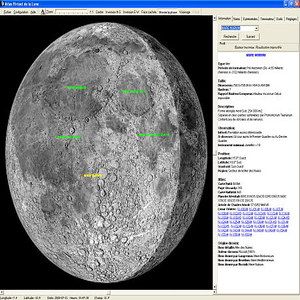

In addition, information about the current Moon phase and libration are provided. Over 1800 named features are included as well as 26 spacecraft that reached the surface of the Moon. The Moon globe can be shown with north or south at the top or inverted to suit different telescope views.

#Moon atlas update#
There is also a realtime mode that will update to the current time. The phase can be switched off and the far side is shown in a slightly darker shade of grey.ĭate, time and location can be changed. The feature database is searchable and can move the globe to a searched feature. You can switch to a 'Globe' mode that allows you to spin the Moon around to see far side features. Moon Atlas displays the phase and libration of the Moon from your chosen location and renders these on the globe. You can double tap on the labels to get more information about a particular feature. As you zoom in more labels appear as finer detail comes into view. This is a rendered sphere and not a static map image. Order from our online store.Moon Atlas is an astronomy application that lets you use pinch and finger gestures to manipulate a 3D globe of the Moon. The maneuver will make Cassini the first craft to ever explore Saturn’s ring gap, making measurements of the mass of the planet’s rings, probing Saturn’s atmosphere and interior structure, and collecting spectacular imagery.įollow Stephen Clark on Twitter: Exploring the Ringed Planetįind out more about Saturn and its moons in this 196-page special edition from Astronomy Now.


#Moon atlas series#
The spacecraft will swing by Saturn’s largest moon Titan, covered in rain-replenished lakes of liquid methane and ethane, on April 22 and use gravity to reshape its orbit and begin a series of passages between the planet’s cloud tops and innermost ring. 15 dive into Saturn’s atmosphere to avoid an inadvertent collision with one of the planet’s potentially habitable moons. Running low on fuel, Cassini is in the final months of its mission, heading for a crushing Sept. Scientists believe the equatorial ridges on Pan and Atlas may have formed as the moons collect grains of ice and dust from nearby rings.Ītlas was discovered in 1980 in imagery taken by the Voyager 1 spacecraft during its encounter with Saturn, and it orbits around 85,500 miles (137,600 kilometers) from the planet, completing one lap every 14.4 hours. Like Pan, Atlas looks like a miniature version of Saturn, with a bulbous central body and a smooth ridge spanning its equator. The disk-shaped moon is about 19 miles (30 kilometers) across, slightly larger than the moon Pan, which is similar in appearance.Ĭassini took the closest-ever pictures of Pan during a flyby in early March, with its shape drawing comparisons to a walnut or ravioli. One of Saturn’s peculiar moons has received an up-close look from NASA’s Cassini spacecraft, which sent back the best-ever pictures of Atlas, an object shaped like a flying saucer orbiting just outside the planet’s rings.Ĭassini took the images of Atlas on April 12 as it passed within about 7,000 miles (11,000 kilometers) of the airless moon.Ītlas circles Saturn just outside the A ring, the outermost of the planet’s main, bright rings, according to NASA. Credit: NASA/JPL-Caltech/Space Science Institute This unprocessed image of Saturn’s moon Atlas was taken on April 12, 2017, by NASA’s Cassini spacecraft.


 0 kommentar(er)
0 kommentar(er)
